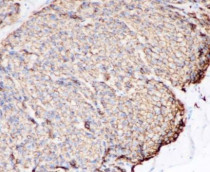ARG66250
anti-DOG1 antibody [SQab1739]
anti-DOG1 antibody [SQab1739] for IHC-Formalin-fixed paraffin-embedded sections and Human
Overview
| Product Description | Recombinant Rabbit Monoclonal antibody [SQab1739] recognizes DOG1 |
|---|---|
| Tested Reactivity | Hu |
| Tested Application | IHC-P |
| Host | Rabbit |
| Clonality | Monoclonal |
| Clone | SQab1739 |
| Isotype | IgG |
| Target Name | DOG1 |
| Antigen Species | Human |
| Immunogen | Synthetic peptide around the C-terminus of Human DOG-1. |
| Conjugation | Un-conjugated |
| Alternate Names | TMEM16A; ORAOV2; Transmembrane protein 16A; Discovered on gastrointestinal stromal tumors protein 1; TAOS2; Tumor-amplified and overexpressed sequence 2; Anoctamin-1; Oral cancer overexpressed protein 2; DOG1 |
Application Instructions
| Application Suggestion |
|
||||
|---|---|---|---|---|---|
| Application Note | IHC-P: Antigen Retrieval: Boil tissue section in Tris/EDTA buffer (pH 9.0). * The dilutions indicate recommended starting dilutions and the optimal dilutions or concentrations should be determined by the scientist. |
Properties
| Form | Liquid |
|---|---|
| Purification | Purification with Protein A. |
| Buffer | PBS, 0.01% Sodium azide, 40% Glycerol and 0.05% BSA. |
| Preservative | 0.01% Sodium azide |
| Stabilizer | 40% Glycerol and 0.05% BSA |
| Storage Instruction | For continuous use, store undiluted antibody at 2-8°C for up to a week. For long-term storage, aliquot and store at -20°C. Storage in frost free freezers is not recommended. Avoid repeated freeze/thaw cycles. Suggest spin the vial prior to opening. The antibody solution should be gently mixed before use. |
| Note | For laboratory research only, not for drug, diagnostic or other use. |
Bioinformation
| Database Links | |
|---|---|
| Gene Symbol | ANO1 |
| Gene Full Name | anoctamin 1, calcium activated chloride channel |
| Function | Calcium-activated chloride channel (CaCC) which plays a role in transepithelial anion transport and smooth muscle contraction. Required for the normal functioning of the interstitial cells of Cajal (ICCs) which generate electrical pacemaker activity in gastrointestinal smooth muscles. Acts as a major contributor to basal and stimulated chloride conductance in airway epithelial cells and plays an important role in tracheal cartilage development. [UniProt] |
| Highlight | Related products: Anti-Rabbit IgG secondary antibodies; Related news: Cancer Pathology Markers (SQ clones) |
| Calculated MW | 114 kDa |
Images (1) Click the Picture to Zoom In






